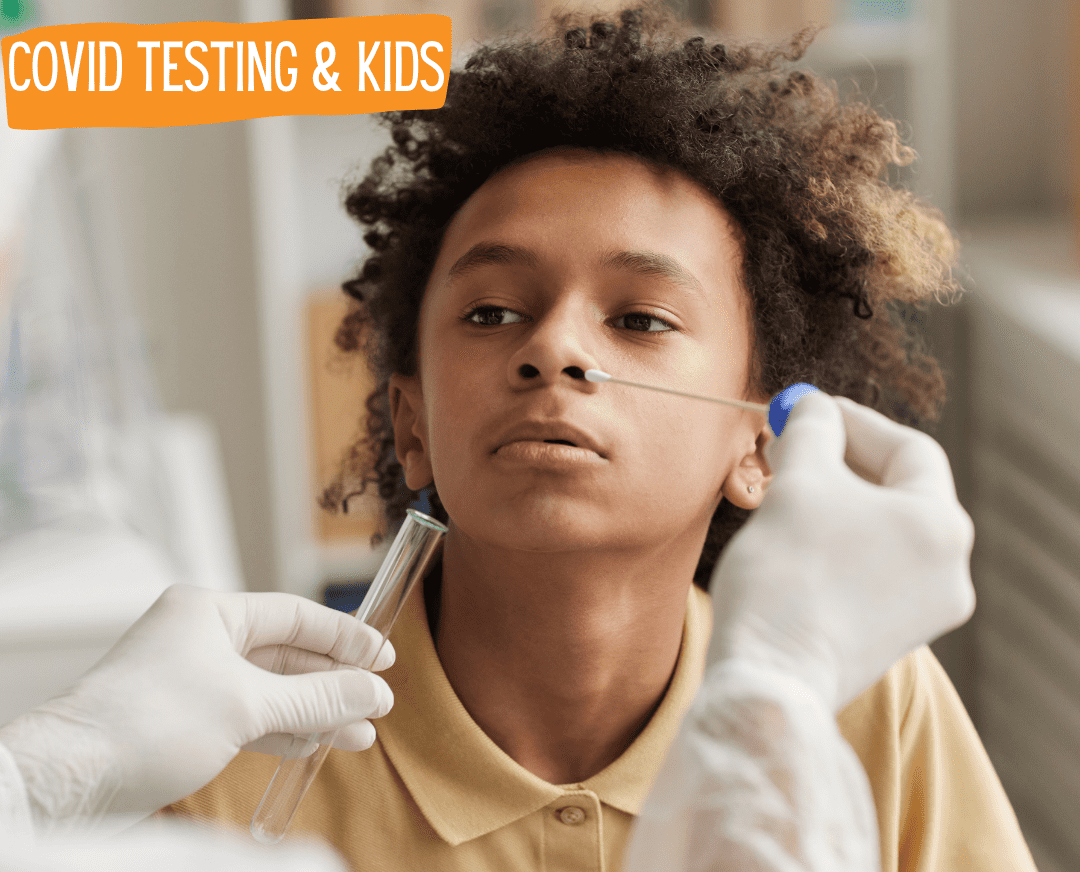COVID Testing and Kids: When is it necessary and which test is best?
We are nearly two years into this pandemic and it’s important to know when to get your child tested for COVID-19. Testing is important to reduce the spread of illness. Because COVID-19 is a virus without any treatment in children under 12, testing in this group is to reduce the risk of spread of this virus in daycares, schools, and with friends.
For children over 12 with moderate to severe symptoms, the FDA has approved monoclonal antibody therapy. In that case, having a positive diagnosis can help in this situation.

Looking for Things to Do in Tampa Bay?
>>This Week’s Favorite Events
>> Summer Break Fun
>> 40+ Free Things to Do with Kids
So, first…
What are the symptoms of COVID-19 in kids?
We still see a wide range of symptoms. Some children are asymptomatic (no symptoms), some have mild symptoms (runny nose, cough, and/or stomach upset), and some have fever and cough.
According to the CDC, here is a list of symptoms we see in COVID-19 in kids:
- Fever
- Fatigue
- Headache
- Myalgia
- Cough
- Nasal congestion or rhinorrhea
- New loss of taste or smell
- Sore throat
- Shortness of breath or difficulty breathing
- Abdominal pain
- Diarrhea
- Nausea or vomiting
- Poor appetite or poor feeding
These are symptoms that we commonly see in MANY viruses. So, we often say that we can’t fully rule out COVID-19 based on the symptom profile. Anything with viral symptoms can be COVID-19 until proven otherwise. The most common symptoms in children were cough and fever, although do remember that many kids can have mild symptoms.
So, does your child have to be tested for every runny nose and cough?
Well, it depends on where you live, the positivity rate in your community, and if you have a known exposure. If you live in Florida where the positivity rate is over 16% as I currently write this blog, testing is recommended given the virus is highly circulating.
A positivity rate means that for everyone who got tested, 16% were positive. The WHO would like to see a positivity rate under 5% to consider that low spread.
If your child has fever and cough:
- I highly recommend getting tested for COVID if you are in an area of high transmission of COVID. If in an area of low transmission, follow guidelines set forth by schools/local recommendations.
If your child has viral symptoms that do not involve a fever:
- Testing would be recommended if you have any known exposure and/or live in an area with high transmission (positivity rate over 5%).
- This means that testing can be frequent, however this is important to make sure your child doesn’t spread SARS-COV-2 if they are positive.
So, this means that for any new runny nose, cough, vomiting, and/or diarrhea as mentioned above in the symptom guide from the CDC, testing is recommended if you are in a place with high transmission.
According to the CDC:
- If the child has symptoms of COVID-19 and has increased likelihood for exposure (which includes living in or traveling to a community with substantial transmission), he or she should be tested for SARS-CoV-2 infection.
- If the test result is negative, the child should be allowed to return to school once their symptoms of illness have improved consistent with non-COVID return to school policies.
- If testing cannot be obtained, the child should be considered a presumed case of COVID-19 and should isolate.
What if your child is well-appearing and doesn’t attend childcare or school?
You can defer testing since your child will be staying home, however remember to monitor symptoms and exposure to any family members in the home who are not vaccinated. Although they are not in school, we also want to reduce risk of spread to loved ones when possible.
If you live in an area with high transmission and your child is symptomatic with viral symptoms, stay home for 10 days if you choose to not get tested. Avoid playdates to reduce chance of spread if this is in fact SARS-COV-2.
What test is best?
Remember, that no test is 100%, but our goal is to get the most accurate test available.
The best test is a PCR test. They are 98% accurate (which means a low chance of being falsely negative—saying you don’t have SARS-COV-2 when you have SARS-COV-2). The results can take 1-2 days to come back.
The other option is a rapid antigen test which takes 10-30 minutes.
The rapid antigen test is more useful for screening purposes. These are available OTC at drug stores and in many testing sites.
- If schools need to do monitoring of kids with no symptoms, a rapid test is useful.
- If your child is exposed or having symptoms, a rapid test is okay; but if it is negative (normal), confirmation with a PCR test is recommended.
PCR is best for any child who has had a known exposure or any child with symptoms. There are two types of PCR tests—saliva (oral) or nasal (nose).
- According to data we have, both are effective in picking up SARS-COV-2, so choose whichever method is available to you.
- The oral method may be tolerable to more kids, so it is a safe and effective option to consider.
For travel via airplane:
- A PCR test is best.
- Many airports accept rapid antigen tests and even perform them which is an okay alternative given masking rules on planes. (An added layer of protection if in fact there’s a false negative on a rapid test). But a PCR would be most ideal
When is the best time to get tested? These recommendations take into consideration having enough viral load to be tested on specimens.
- If symptomatic:
- A rapid test early in the illness is okay (ideally day 2 or beyond of symptoms), however a PCR should be done to confirm.
- If asymptomatic, but was exposed:
- a PCR on day 3-5 past from the exposure would be ideal.
- If asymptomatic and using for travel or screening:
- Anytime is okay.
So, what about quarantine and isolation?
- We quarantine if you were exposed to a virus until we have testing to confirm we are negative.
- We isolate if we are positive and are waiting to return to school/daycare/etc.
According to the CDC:
- Quarantine if you have been in close contact within 6 feet of someone for a cumulative total of 15 minutes or more over a 24-hour period) with someone who has COVID-19 unless you have been fully vaccinated.
- People who are fully vaccinated do NOT need to quarantine after contact with someone who had COVID-19 unless they have symptoms.
- However, fully vaccinated people should get tested 3-5 days after their exposure, even if they don’t have symptoms and wear a mask indoors in public for 14 days following exposure or until their test result is negative.
- If exposed, quarantine should last 10 days without testing or 7 days after receiving a negative test that was ideally done on day 5 or after from the exposure.
If positive for SARS-COV-2, use the following recommendations:
- If symptomatic and tested positive, your child can return to activities:
- 10 days since symptoms first appeared and
- 24 hours with no fever without the use of fever-reducing medications and
- Other symptoms of COVID-19 are improving
- If asymptomatic (no symptoms) and tested positive, your child can return to activities:
- If you continue to have no symptoms, you can be with others after 10 days have passed since you had a positive viral test for COVID-19.
- If you develop symptoms after testing positive, follow the guidance above for “I think or know I had COVID-19, and I had symptoms.”
Remember, testing is to prevent the spread of this virus. Although your child may not be high risk for complications, others may be. So, testing helps reduce the spread of this virus until more children are offered the vaccine.
Sources:
- https://www.cdc.gov/coronavirus/2019-ncov/hcp/pediatric-hcp.html
- https://jamanetwork.com/journals/jamainternalmedicine/fullarticle/2775397?guestAccessKey=8058e841-bc18-4398-a251-54087a84297f&utm_source=silverchair&utm_medium=email&utm_campaign=article_alert-jamainternalmedicine&utm_content=olf&utm_term=011521
- https://coronavirus.jhu.edu/testing/testing-positivity
- https://covid.cdc.gov/covid-data-tracker/#mis-national-surveillance
- https://www.cdc.gov/coronavirus/2019-ncov/your-health/quarantine-isolation.html
*Sponsored by Pediatric Associates of Tampa Bay






